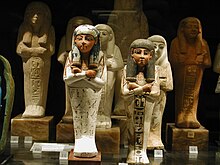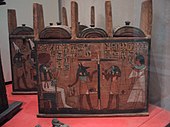Ushabti

A ushabti , also shabti , shawabti , is a statuette in the archeology of ancient Egypt , often in the form of a mummy , which has embodied a deceased person since the Middle Kingdom .
Description and use
The oldest shabtis were made of wax or Nile mud. Soon afterwards stone, wood or faience were also used as material. The faience was often glazed blue (blue-green). Faience prevailed because of the possibility of series production. Towards the end of the New Kingdom, shabtis were predominantly made from this material. Bronze shabtis are extremely rare. It is usually 10 to 20 cm long. However, there are also much larger specimens. The largest ushabti figure found is probably the life-size stone ushabti of Kenamun. Shabtis were also placed in the grave, but could also be deposited in holy places, whereby the deceased or a person could symbolically be present at this place. For example, said shabti figure of Kenamun, which was set up in the temple, "to document the time off work at a holy place". Especially from the end of the 17th and the beginning of the 18th dynasties, there are numerous rough ushabtis ( stick shabtis ) cut from wood , most of which only have a short inscription. They were deposited at the burial chapels by friends and family members. So they could symbolically be close to the deceased.
It was not until the 18th dynasty that the shabtis became the rule in the graves. Here he has a helper role. According to the religious beliefs of the ancient Egyptians, the deceased calls on the ushabti in the world of the dead to do various work for him, especially in the agricultural sector.
history
The first ushabtis have been documented since the beginning of the Middle Kingdom . The earliest wax specimens appeared in Saqqara during the reign of Herakleopolis and in Deir el-Bahari during the 11th dynasty under Mentuhotep II . During this time, they seem to primarily depict and represent the dead. Since the New Kingdom at the latest , the ushabtis have been seen as workers, who have been followed since the 19th dynasty by overseer figures who are not in the form of mummies.
Especially since the New Kingdom, the shabtis were given to the dead in the grave. They were often provided with the name of the dead person in question in order to answer his name during the court of the dead and to serve as his representative. If the deceased was called in the hereafter, for example, to sow the fields or to fill the canals with water, the ushabti should answer: “Here I am.” “O you ushabti, if I am obliged to do any work, which is done there in the realm of the dead - namely, if a man is condemned there to his (work) performance - then you commit yourself to what is done there to till the fields and to water the banks to remove the sand (Manure) of the East and the West to run over. ,I want to do it. Here I am 'you should say. "The full section reads:" O you ushabti, if I am obliged to do any work that is done there in the realm of the dead - namely, if a man is condemned there to his work -, then you undertake to do what is being done there to till the fields and to irrigate the banks to run over the sand (manure) of the east and west. ,I want to do it. Here I am 'you should say' (6th chapter of the Book of the Dead ). So that the shabti could do the work assigned to the deceased, especially field work, small models of the devices that the shabti held in his hands were given to him in older times. In later times the devices were painted on the figures.
Depending on the social status and wealth of the deceased, a greater or lesser number of shabtis were added to the grave. While in the 18th dynasty there were mostly only single specimens , the number could be much higher in the late period . For example, 365 of these figures were found in several graves - one for each day of the year. From the end of the 18th Dynasty, from the height of the New Kingdom to the Ptolemies, they were supplemented by overseer figures, sometimes one for all other ushabti, sometimes one for 10 days. So it happened that even 401 or 402 figures were placed in the grave. The guard had to make sure that the shabti was doing the work properly. He was carried out with a stick and whip for this. Pharaohs , however, sometimes even had over 1,000 large ushabtis in their graves.
The socially lower classes also had shabtis in their graves. For them, too, they were the magical gateway to influence in the world of the dead. At the end of the Ptolemaic rule, around 30 BC, the ancient Egyptian tradition was completely torn down and the shabtis disappeared as grave goods.
Shabti boxes
The so-called ushabti boxes were used to store the ushabti figures that were given to the deceased pharaohs and higher officials in their graves. They have been known since the 18th dynasty, but then become particularly popular in the 19th dynasty. At first they contain only two or three ushabtis, in the later period it can be up to 400. In addition to the shabti boxes, which are particularly typical of Thebes , painted and labeled vessels were often used as containers for shabtis in other necropolises .
gallery
Shabti of the Nubian Queen Pianchher , British Museum, London
See also
literature
- Martin Fitzenreiter, Christian E. Loeben (Ed.): The Egyptian mummy a phenomenon of cultural history. The Egyptian mummies and mummification as a specific phenomenon of ancient Egyptian culture and their reception as a phenomenon of European culture: a case study on the image of ancient Egypt (= Internet contributions to Egyptology and Sudan archeology (IBAES). Vol. 1, ZDB -ID 2574789 -7 ). Contribution to a workshop at the seminar for Sudanese archeology and Egyptology at the Humboldt University in Berlin (April 25 and 26, 1998). Humboldt-Universität zu Berlin Seminar for Sudan Archeology and Egyptology, Berlin 1998, online (PDF; 1.5 MB) .
- Wolfgang Helck , Eberhard Otto (Ed.): Small Lexicon of Egyptology. 4th, revised edition. Harrassowitz, Wiesbaden 1999, ISBN 3-447-04027-0 .
- Wolfgang Helck, Eberhard Otto, Wolfhart Westendorf (Hrsg.): Lexicon of Egyptology. Volume VI: Stele - Cypress. Harrassowitz, Wiesbaden 1986, ISBN 3-447-02663-4 .
- Manfred Lurker : Lexicon of the gods and symbols of the ancient Egyptians. Handbook of the mystical and magical world of Egypt. Special edition. Scherz, Bern et al. 1998, ISBN 3-502-16430-4 .
- Hans D. Schneider: Shabtis. An introduction to the history of ancient Egyptian funerary statuettes with a catalog of the collection of shabtis in the National Museum of Antiquities at Leiden (= Collections of the National Museum of Antiquities at Leiden 2, ZDB -ID 751424-4 ). 3 volumes (Vol. 1: An Introduction to the History of ancient Egyptian funerary Statuettes. Volume 2: A Catalog of the Collection of Shabtis in the National Museum of Antiquities at Leiden. Vol. 3: Illustrations. ). Rijksmuseum van Oudheden, Leiden 1977, (the basic work on the ushabtis).
- Paul Whelan: Mere Scraps of Rough Wood? 17th - 18th Dynasty Stick Shabtis in the Petrie Museum and Other Collections (= Egyptology. Vol. 6). Golden House Publications, London 2007, ISBN 978-1-906137-00-7 .
Web links
- Internet articles on Egyptology and Sudan archeology Vol. I (Humboldt University Berlin, seminar for Sudan archeology and Egyptology)
- Shabtis on Digital Egypt (English with many pictures)
- (numerous images) ( Memento from September 14, 2007 in the Internet Archive ) (numerous images)
- (numerous images) (numerous images)
- (numerous images) (numerous images)
- Afterlife in Egypt. Museum in Berlin
- Holger Kockelmann: Ushebti . In: Michaela Bauks, Klaus Koenen, Stefan Alkier (Eds.): The Scientific Biblical Lexicon on the Internet (WiBiLex), Stuttgart 2006 ff.
Remarks
- ↑ Naming since the late period. H. Schlögl: Uschebti. In: W. Helck, W. Westendorf (Hrsg.): Lexikon der Ägyptologie. Volume VI, Wiesbaden 1986, column 896.
- ↑ This is the oldest name. H. Schlögl: Uschebti. In: W. Helck, W. Westendorf (Hrsg.): Lexikon der Ägyptologie. Volume VI, Wiesbaden 1986, column 896.
- ↑ Shawabti only appears after Shabti and before Shabti. H. Schlögl: Uschebti. In: W. Helck, W. Westendorf (Hrsg.): Lexikon der Ägyptologie. Volume VI, Wiesbaden 1986, column 896.
- ↑ a b c H. Schlögl: Uschebti. In: W. Helck, W. Westendorf (Hrsg.): Lexikon der Ägyptologie. Volume VI, Wiesbaden 1986, column 896.
- ↑ a b H. Schlögl: Uschebti. In: W. Helck, W. Westendorf (Hrsg.): Lexikon der Ägyptologie. Volume VI, Wiesbaden 1986, column 898.
- ↑ One of the very few examples is the bronze ushabti from the burial equipment of Psusennes I, from the 21st dynasty (around 1000 BC). Image and description can be found on the homepage of the State Museum of Egyptian Art in Munich .
- ↑ a b c H. Schlögl: Uschebti. In: W. Helck, W. Westendorf (Hrsg.): Lexikon der Ägyptologie. Volume VI, Wiesbaden 1986, column 897.
- ^ P. Whelan: Mere Scraps of Rough Wood? ... London 2007.
- ↑ The early ushabti had no inscription, or only the name of the deceased. Only in the 12th dynasty is a sacrificial formula occasionally added. “For the first time at the turn of the 12th to the 13th dynasty”, versions of the 6th verse of the Egyptian Book of the Dead are used. H. Schlögl: Uschebti. In: W. Helck, W. Westendorf (Hrsg.): Lexikon der Ägyptologie. Volume VI, Wiesbaden 1986, column 896.
- ↑ “O you ushabti, if I am obliged to do any work that is done there in the realm of the dead - namely, if a man is condemned there to his (work) performance - then you undertake (to) what is done there is used to till the fields and irrigate the banks to drive over the sand (manure) of the east and west. ,I want to do it. Here I am, 'you should say. ”H. Schlögl: Uschebti. In: W. Helck, W. Westendorf (Hrsg.): Lexikon der Ägyptologie. Volume VI, Wiesbaden 1986, column 896.




